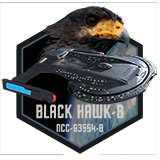
| |
| Security/Tactical Department | |
| Department Colors: | |
| Template:Department | |
The Starfleet Security agency is responsible for security aboard all Starfleet and some Federation outposts, vessels, and facilities. In this function, they act in ways analogous to local and regional police agencies, but Starfleet Security's mandate extends much farther than that. The agency is responsible for maintaining and enforcing Starfleet Security regulations, procedures and policies on all Starfleet and affiliated facilities, outposts, and vessels. In addition, this agency is responsible for security clearances of all Starfleet/UFP personnel.
The agency, in close cooperation with Starfleet Intelligence, is responsible for counter-intelligence operations. The agency is also responsible for the security of the Federation President, as well as members of the Federation Council and visiting alien dignitaries.
It is uncertain what relationship exists (if any) between Starfleet Security and the secretive and unofficial Federation agency Section 31.
Aboard Starfleet-run facilities and vessels, security was one of the most important divisions in the 23rd and 24th centuries, combining the armory and MACO functions of the 22nd century. Security personnel served functions both defensive and offensive, ranging from security patrols on board a starship, to guarding prisoners, to firing the ship's weapons, to providing protection during landing party/away team missions, and more. In the 24th century the officer in charge of security on a starship was given the title of Security Chief.
Positions & Roles
- Main Article: Security and Tactical Positions
The following are typical Security/Tactical positions:
- Chief Security/Tactical Officer
- Assistant Chief Security Officer
- Assistant Chief Tactical Officer
- Armory Officer
- Master-At-Arms
- Warden
To read more about these roles, and to review the other roles in this department, please review the complete list of Security and Tactical Positions.
Sub Sections of Starfleet Security
- Office of the Director - Consisting of the Starfleet Security Counsel and Board of Directors, this is the top tier of Starfleet Security. All Security related Decisions come through this Office. Commander, Starfleet Security, stationed on Earth, in San Francisco, runs division from Headquarters. Assistant Commander, Starfleet Security, stationed on earth when not on field duty (acts as the eyes and ears of the Security Commander in the field, relationship very much like that of a vessel CO and FO).
- Administrative Services Division - Security Issues are channeled through Administrative Services on their way to the Office of the Director. Responsibilities of this division include determining which wing of Starfleet Security is best for handling a given situation, and channeling important information directly to the Head of Starfleet Security.
- Internal Security Division - Investigates Potential threats to the Internal Security of the Federation/
- Criminal Investigative Division - Under the direct authority of Internal Security and working with Starfleet Intelligence, Criminal Investigation identifies and monitors potential and known criminals for the purpose of determining who poses a threat against Starfleet and the Federation.
- Criminal Justice Division - Works in conjunction with the Federation JAG to prosecute criminals.
- Internal Affairs Division - Takes information on potential threats and uses it safeguard Starfleet Personnel. Works with Internal Inspection to investigate internal threats to the Federation.
- Strategic Operations Command Division - Works with Starfleet Tactical to develop new methods for defending the Internal Security of the Federation.
- Internal Inspection Division - Performs High Level Review of suspected spies and traitors within Starfleet. Works with Internal Affairs to Investigate internal threats to the Federation (Its believed that most Section 31 Agents had their start here).
- Public Services Division - Acts as "Public Relations" Division for cases and situations of a nature sensitive enough to be kept from the general public.
- Forensics Division - Works with Starfleet Medical and the Federation JAG to Investigate Criminal Activity from a scientific, medical, and legal standpoint.
- Federation Security Division - Ensures that Security personnel are present on all Federation Starships, Installations, and Planets.
Training
Security forces provide basic police duties on ship, as well as protective duties to landing parties. Some Security personnel will take additional training as StarFleet Marines, but this is rare. Usually, Security officers minor in Com/Ops.
Only after they graduate in a major, they may go on to specialize in a field, if preferred.
Duties
Guarding Vital Areas
One of the primary duties of the Security department on board a starship or starbase is safeguarding vital areas that may be vulnerable to theft or sabotage, or that might draw intruders. Such areas include the bridge, main engineering, the central computer core, cargo bays containing valuable goods, the shuttlebays, and the brig. When the ship or station is not on alert, guards are routinely posted at security stations on the decks located near these vital areas, able to monitor the security scanners and respond quickly if there is a need.
For a yellow alert, security personnel are placed on guard at vital points throughout the ship. They may be given special orders regarding access to those facilities (such as allowing no one but the Captain and First Officer access). The security guards allow access to authorized crew members unless ordered otherwise. The Captain, First Officer, or Security Chief can also give certain crew members access privileges, as needed.
Under red alert, security guards are posted on all decks, as well as vital areas of the ship. If an intruder alert is sounded, security personnel guard all turbolifts and airlocks, and begin sweeping the ship for signs of intruders. Information is relayed back to the main computer and the Security Chief.
Standard procedure calls for at least one security guard on duty in the transporter room when unknown or potentially dangerous individuals transport on board. The transporter chief can hold such individuals in stasis in the pattern buffer if necessary to await the arrival of security, and transporter scanners automatically detect any dangerous weapons or other devices, and can render them inoperative before the subject rematerializes, making security's job easier.
Guarding the Captain
One of the prime duties of Security is safeguarding the commanding officer of a starship or station. The captain is considered a vital element of the ship, and treated accordingly. The captain should have a security escort at all times in red alert situations, and when beaming down into any situation that might become dangerous. The Security Chief and/or Operations Officer helps to safeguard the captain while on the bridge, but additional security personnel should be present if trouble is expected.
Part of safeguarding the captain involves performing security sweeps of areas before the captain enters or beams into them. Security personnel check for any potential hazards and ensure they are within reasonable limits before the captain arrives. The captain can, of course, override standard security procedures in these matters, but it is not recommended.
Away Team Procedures
Security personnel form a vital part of Away Team Missions and every away team is well-advised to have at least one security officer, more if the Away Mission is expected to encounter trouble (particularly armed resistance). In some cases, away teams may be made up entirely of Security (and Command) personnel. While on an Away Mission, the duties of the Security personnel include:
- Remaining alert for any signs of danger to the crew or mission.
- Safeguarding the lives of all away team members, particularly senior officers.
- Gathering tactical and strategic information regarding any possible threats.
- Taking necessary action to ensure the first three priorities, including the use of force, but only as a last resort.
While all Starfleet personnel on Away Missions are expected to remain alert, it is the security officer's duty to look out for potential threats to the Away Team. This includes the use of tricorder scans for hazards (both natural and artificial) and "reading" the reactions of any life-forms the crew may encounter. The security officer should make recommendations to the commanding officer of the Away Team with regards to appropriate security precautions.
It is important to note that Starfleet security officers are expected to take a defensive posture with regard to possible threats. Stunning (much less injuring) native life-forms "simply because they might pose a threat" is against Starfleet regulations. A strategic withdrawal is normally the most prudent response in a dangerous situation, followed by neutralizing the danger as quickly as possible, if a withdrawal is not an option.
Imprisonment
There are occasions when a Starfleet crew may find itself with prisoners: criminals they have apprehended, captured attackers, or even unknown aliens. In general, Starfleet crews are authorized to keep such individuals imprisoned until they can be turned over to the proper authorities, either of the planet or civilization that has jurisdiction, or to Federation authorities at a Starbase.
Each starship or station is generally equipped with a brig to hold prisoners. The brig consists of one or more cells equipped with force fields and a security station. On board larger ships and space stations brigs are capable of holding a number of prisoners. Smaller ships may only be able to hold a handful, while the smallest ships may not have a brig at all. Crews may resort to using guest or crew-quarters as makeshift cells by locking the door and posting guards (perhaps even reinforcing the door with a force field). Most brigs use force fields to prevent any chance of the prisoner escaping via transporter.
A starship crew is expected to turn any prisoners over to the proper authorities as soon as reasonably possible. The captain, of course, is the judge of what is "reasonable" in these situations. If the ship is already engaged in a mission, the prisoners may be held until that mission is complete and the ship has an opportunity to deal with them. More delicate political and diplomatic situations may require the crew to deal with their prisoners immediately.
Starfleet regulations require that prisoners be treated well, and that all of their life-support needs be met. In the case of non-Federation citizens, the crew should make every effort to contact the proper authorities of the prisoner's home world, although prisoners accused of crimes against Federation personnel or property should be held over while Federation authorities discuss matters of extradition with the prisoner's home civilization.
| STARFLEET COMMAND | |
| IMPORTANT ERRATA | Departments • General Orders • Starship Security Procedures • Operating Modes • Orbits • Bearings and Navigation • Defensive Maneuvers • Offensive Maneuvers |
| PERSONNEL FUNCTIONS | Alert Status • Computer Access Levels • Deck Listing • Department Head • Operating Modes • Positions • Security Clearances • Rank Guide • Rank Comparisons |
| DEPARTMENTS | Command • Flight Control • Intelligence • Operations • Engineering Security/Tactical • Medical • Science • Starfighters • Civilians |
